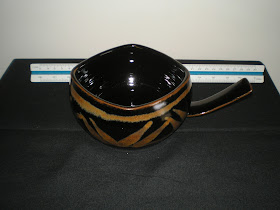Eventually most dinnerware is upgraded for more affluent
diners. This is also the case with
ramekins. Silver tableware had been
around for quite a few centuries but in America towards the end of the
nineteenth century, a number of makers started producing sterling silver
ramekin holders with porcelain inserts.
Usually produced in the Eastern United States to cater to the burgeoning
middle classes, these sets were made by the top silversmiths, for example,
Tiffany sold their own sets made with Lenox porcelain. To go with these myriad sets, ramekin forks
were developed.
A ramekin fork is probably best described as a hybrid
spoon. Known in the US as flatware,
they have short wide tines and a lightly curved bowl attached to a handle because
they are meant to only pick up a small amount of food at a steep angle from
inside a ramekin bowl.
Collectors can be deceived because some unscrupulous
people will remodel an old teaspoon and call it a ramekin fork. This was done by some of the original makers
to use up their old stock and some made by individual makers. It will have the right hallmarks but could
be a modern forgery. Some are old
forgeries because some seconds were remade at the time. Some later ramekin forks were made in
stainless steel. There are also some
European makers of sterling silver ramekins, such as Limoges but in the main it
appears to be a particularly American trend, mostly in the New England area and
around New York.
Not only did these makers produce ramekin forks, they also
made myriad other forks for specific purposes.
The following is a list of many, but probably not all of them.
Asparagus
|
Corn
|
Luncheon
|
Salad
|
Baked Potato
|
Crab
|
Mango
|
Scallop
|
Barbecue
|
Desert
|
Meat
|
Seafood
|
Berry
|
Dinner
|
Melon
|
Serving
|
Bird
|
Escargot (Snail)
|
Olive
|
Souffle
|
Breakfast
|
Fish
|
Oyster
|
Spaghetti
|
Cake
|
Fondue
|
Pastry
|
Strawberry
|
Canape
|
Fruit
|
Pate
|
Tea
|
Carving
|
Garden
|
Pickle
|
Toasting
|
Cheese
|
Grille
|
Pie
|
Terrapin
|
Cherry
|
Ice Cream
|
Pitch
|
Viande
|
Cocktail
|
Lettuce
|
Place
|
|
Cold Cuts
|
Lobster
|
Ramekin
|
Way back in the seventies, that decade that style forgot
but keeps talking about, splayds were an essential gift for any newly married
couple. They are the closest thing to a
ramekin fork today, but are much larger.
Look up other images for ramekin forks and you will see what I mean but don’t
look for any more of them on my site because they can be quite expensive. I copied these pictures.























